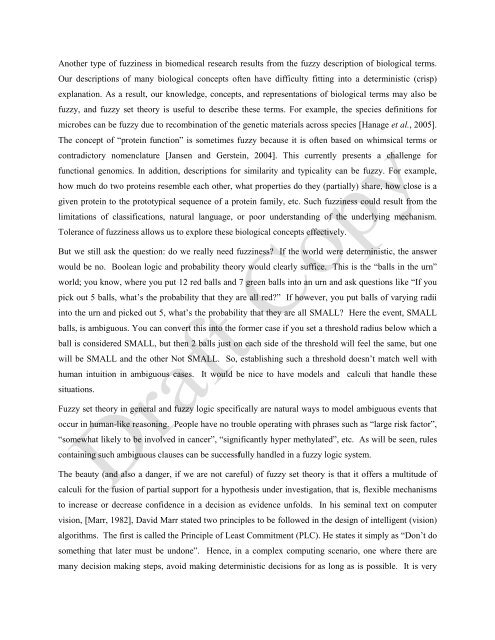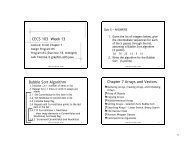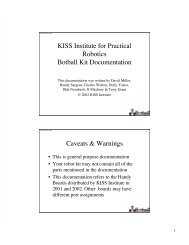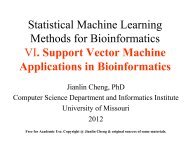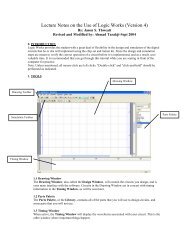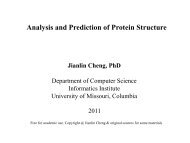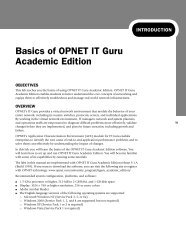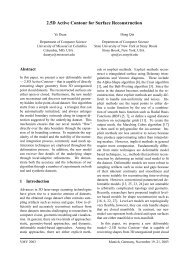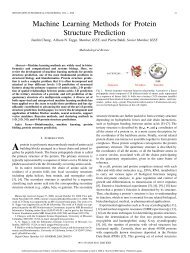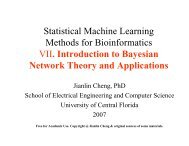Chapter X: Introduction to Fuzzy Set Theory Uncertainty is universal ...
Chapter X: Introduction to Fuzzy Set Theory Uncertainty is universal ...
Chapter X: Introduction to Fuzzy Set Theory Uncertainty is universal ...
You also want an ePaper? Increase the reach of your titles
YUMPU automatically turns print PDFs into web optimized ePapers that Google loves.
Another type of fuzziness in biomedical research results from the fuzzy description of biological terms.<br />
Our descriptions of many biological concepts often have difficulty fitting in<strong>to</strong> a determin<strong>is</strong>tic (cr<strong>is</strong>p)<br />
explanation. As a result, our knowledge, concepts, and representations of biological terms may also be<br />
fuzzy, and fuzzy set theory <strong>is</strong> useful <strong>to</strong> describe these terms. For example, the species definitions for<br />
microbes can be fuzzy due <strong>to</strong> recombination of the genetic materials across species [Hanage et al., 2005].<br />
The concept of “protein function” <strong>is</strong> sometimes fuzzy because it <strong>is</strong> often based on whimsical terms or<br />
contradic<strong>to</strong>ry nomenclature [Jansen and Gerstein, 2004]. Th<strong>is</strong> currently presents a challenge for<br />
functional genomics. In addition, descriptions for similarity and typicality can be fuzzy. For example,<br />
how much do two proteins resemble each other, what properties do they (partially) share, how close <strong>is</strong> a<br />
given protein <strong>to</strong> the pro<strong>to</strong>typical sequence of a protein family, etc. Such fuzziness could result from the<br />
limitations of classifications, natural language, or poor understanding of the underlying mechan<strong>is</strong>m.<br />
Tolerance of fuzziness allows us <strong>to</strong> explore these biological concepts effectively.<br />
But we still ask the question: do we really need fuzziness? If the world were determin<strong>is</strong>tic, the answer<br />
would be no. Boolean logic and probability theory would clearly suffice. Th<strong>is</strong> <strong>is</strong> the “balls in the urn”<br />
world; you know, where you put 12 red balls and 7 green balls in<strong>to</strong> an urn and ask questions like “If you<br />
pick out 5 balls, what’s the probability that they are all red?” If however, you put balls of varying radii<br />
in<strong>to</strong> the urn and picked out 5, what’s the probability that they are all SMALL? Here the event, SMALL<br />
balls, <strong>is</strong> ambiguous. You can convert th<strong>is</strong> in<strong>to</strong> the former case if you set a threshold radius below which a<br />
ball <strong>is</strong> considered SMALL, but then 2 balls just on each side of the threshold will feel the same, but one<br />
will be SMALL and the other Not SMALL. So, establ<strong>is</strong>hing such a threshold doesn’t match well with<br />
human intuition in ambiguous cases. It would be nice <strong>to</strong> have models and calculi that handle these<br />
situations.<br />
<strong>Fuzzy</strong> set theory in general and fuzzy logic specifically are natural ways <strong>to</strong> model ambiguous events that<br />
occur in human-like reasoning. People have no trouble operating with phrases such as “large r<strong>is</strong>k fac<strong>to</strong>r”,<br />
“somewhat likely <strong>to</strong> be involved in cancer”, “significantly hyper methylated”, etc. As will be seen, rules<br />
containing such ambiguous clauses can be successfully handled in a fuzzy logic system.<br />
The beauty (and also a danger, if we are not careful) of fuzzy set theory <strong>is</strong> that it offers a multitude of<br />
calculi for the fusion of partial support for a hypothes<strong>is</strong> under investigation, that <strong>is</strong>, flexible mechan<strong>is</strong>ms<br />
<strong>to</strong> increase or decrease confidence in a dec<strong>is</strong>ion as evidence unfolds. In h<strong>is</strong> seminal text on computer<br />
v<strong>is</strong>ion, [Marr, 1982], David Marr stated two principles <strong>to</strong> be followed in the design of intelligent (v<strong>is</strong>ion)<br />
algorithms. The first <strong>is</strong> called the Principle of Least Commitment (PLC). He states it simply as “Don’t do<br />
something that later must be undone”. Hence, in a complex computing scenario, one where there are<br />
many dec<strong>is</strong>ion making steps, avoid making determin<strong>is</strong>tic dec<strong>is</strong>ions for as long as <strong>is</strong> possible. It <strong>is</strong> very


